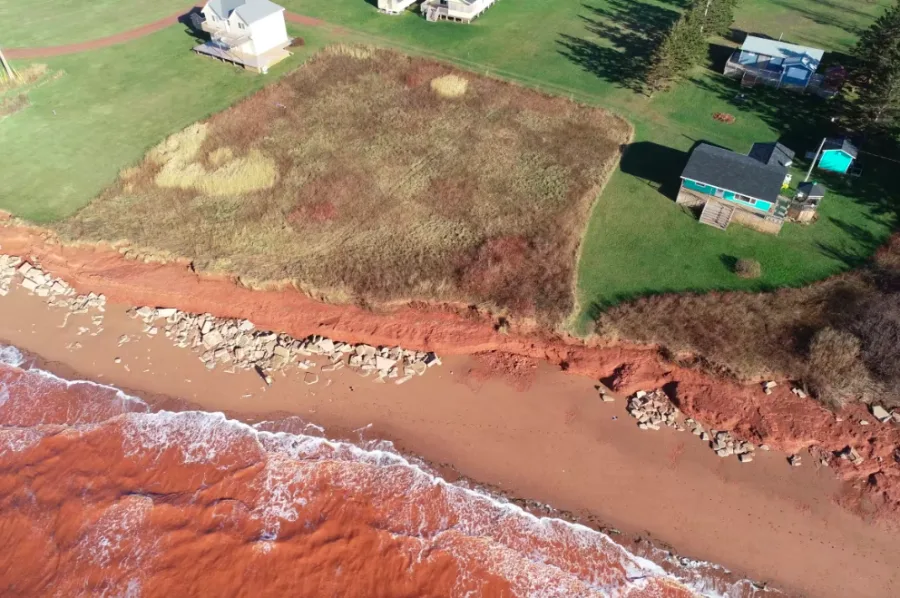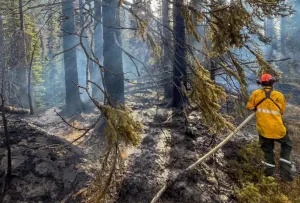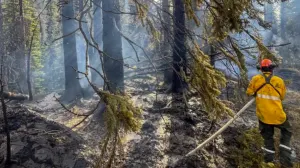
Drones record 'unprecedented' damage to P.E.I.'s coastline from Fiona
Andy MacDonald and Luke Meloche have been getting a bird's-eye view of the destruction from post-tropical storm Fiona, taking the UPEI Climate Lab drones around Prince Edward Island to survey the coastline.
MacDonald has been involved with UPEI's coastline monitoring project since it started in 2016, doing on-the-ground measurements at 100 sites, along with drone surveys.
But what they saw in the wake of Fiona was "unprecedented," he said.
"The largest losses we've seen — which were very rare — were in the five-metre-loss areas," MacDonald said.
"But after this storm, we've seen areas with more than 10 metres lost, sustained over an area which we've never seen before, and which we've never seen in the historical records either."
The drone crew, now based at the Canadian Centre for Climate Change and Adaptation in St. Peter's Bay, was able to visit more than 25 sites, capturing video and still images from the sky.

Drone pilots Andy MacDonald, left, and Luke Meloche spent the weeks after post-tropical storm Fiona surveying the damage to P.E.I.'s coastline. (Shane Hennessey/CBC)
"Aside from our own interest, [we had] a lot of requests from different departments across Prince Edward Island, different organizations, watershed groups, different municipalities, national parks," MacDonald said.
"But we just want to be able to capture as much imagery as we can in order to have a better understanding of the damage, and in which parts of the Island the most damage occurred."
See also: Nova Scotia’s ambitious climate plan aims to phase out coal
'Heart-wrenching' damage
Meloche has been with the coastal monitoring program since 2019, and was struck by the damage from Fiona.
"It was kind of heart-wrenching. You'd show up to places, there'd be empty foundations. You'd be driving along the coast and you'd see the wreckage of someone's house washed up," the drone pilot said.
"There'd be huge stretches of coastal road where we'd drive before, and now there's no road."

Savage Harbour is one of the communities where the drone crew found extensive damage caused by post-tropical storm Fiona. (Canadian Centre for Climate Change and Adaptation)
Meloche said the damage from Fiona will help researchers decide where to focus their monitoring work in the years ahead.
"I expect it's going to add a lot more interest, and we may end up with a lot more sites," Meloche said.
"Right now, we're flying around 107 sites around the Island, but more people are going to be interested. They'll see that, 'Hey, this area was hit really hard. Can you add somewhere there?' And hopefully we can oblige with that."

These cliffs in Ebbsfleet in western P.E.I. were hit hard by Fiona. (Canadian Centre for Climate Change and Adaptation)
Future decisions
MacDonald also said coastal monitoring will be important in the years ahead as Islanders — and governments — grapple with cost-effective ways of dealing with climate change.
"I think that as an island made of sandstone, figuring out a way to protect our coastlines is important," he said.
"Coastal armouring on P.E.I. is certainly a complicated question. I think you're seeing a lot of people who ended up paying for a lot of coastal armouring that didn't end up being overly effective.

The drone pilots say coastal monitoring will be important in the years ahead as Islanders, and governments, grapple with how to deal with climate change. (Canadian Centre for Climate Change and Adaptation)
"Spending tens of thousands of dollars to armour your personal coastline might not be the kind of simple fix that perhaps some folks thought it would be."
MacDonald said there will be years of research to be done around the impact of Fiona.
"There's certainly a lot of interest in looking at the data after Fiona — whether that is aerial imagery, weather station data, tide loggers," he said. "We've had a lot of colleagues asking from different departments about the information we have."

MacDonald has been involved with UPEI's coastline monitoring project since it started in 2016. (Shane Hennessey/CBC)
"I could certainly see some master's projects, some PhD projects, some class projects coming out of this event," MacDonald said.
"I don't think anyone will be forgetting Fiona anytime soon."
This article, written by Nancy Russell, was originally published for CBC News.
Thumbnail image: Kite Point, near Malpeque, suffered damage from post-tropical storm Dorian in August of 2019, but even more shoreline was destroyed by post-tropical storm Fiona this past September. (Canadian Centre for Climate Change and Adaptation)










